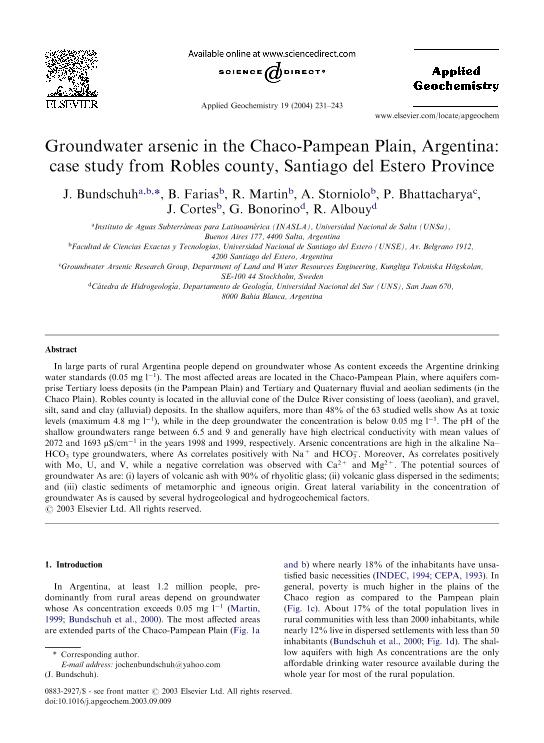Artículo
Groundwater arsenic in the Chaco-Pampean Plain, Argentina: Case study from Robles county, Santiago del Estero Province
Bundschuh, J.; Farias, B.; Martin, R.; Storniolo, Angel del Rosario; Bhattacharya, P.; Cortes, J.; Bonorino, Alfredo Guillermo ; Albouy, Edgardo René
; Albouy, Edgardo René
 ; Albouy, Edgardo René
; Albouy, Edgardo René
Fecha de publicación:
02/2004
Editorial:
Pergamon-Elsevier Science Ltd
Revista:
Applied Geochemistry
ISSN:
0883-2927
Idioma:
Inglés
Tipo de recurso:
Artículo publicado
Clasificación temática:
Resumen
In large parts of rural Argentina people depend on groundwater whose As content exceeds the Argentine drinking water standards (0.05 mg l 1). The most affected areas are located in the Chaco-Pampean Plain, where aquifers comprise Tertiary loess deposits (in the Pampean Plain) and Tertiary and Quaternary fluvial and aeolian sediments (in the Chaco Plain). Robles county is located in the alluvial cone of the Dulce River consisting of loess (aeolian), and gravel, silt, sand and clay (alluvial) deposits. In the shallow aquifers, more than 48% of the 63 studied wells show As at toxic levels (maximum 4.8 mg l 1), while in the deep groundwater the concentration is below 0.05 mg l 1. The pH of the shallow groundwaters range between 6.5 and 9 and generally have high electrical conductivity with mean values of 2072 and 1693 mS/cm 1 in the years 1998 and 1999, respectively. Arsenic concentrations are high in the alkaline Na– HCO3 type groundwaters, where As correlates positively with Na+ and HCO3 . Moreover, As correlates positively with Mo, U, and V, while a negative correlation was observed with Ca2+ and Mg2+. The potential sources of groundwater As are: (i) layers of volcanic ash with 90% of rhyolitic glass; (ii) volcanic glass dispersed in the sediments; and (iii) clastic sediments of metamorphic and igneous origin. Great lateral variability in the concentration of groundwater As is caused by several hydrogeological and hydrogeochemical factors.
Palabras clave:
Groundwater
,
Arsenic
,
Plain
,
Argentina
Archivos asociados
Licencia
Identificadores
Colecciones
Articulos(INGEOSUR)
Articulos de INST.GEOLOGICO DEL SUR
Articulos de INST.GEOLOGICO DEL SUR
Citación
Bundschuh, J.; Farias, B.; Martin, R.; Storniolo, Angel del Rosario; Bhattacharya, P.; et al.; Groundwater arsenic in the Chaco-Pampean Plain, Argentina: Case study from Robles county, Santiago del Estero Province; Pergamon-Elsevier Science Ltd; Applied Geochemistry; 19; 2; 2-2004; 231-243
Compartir
Altmétricas



